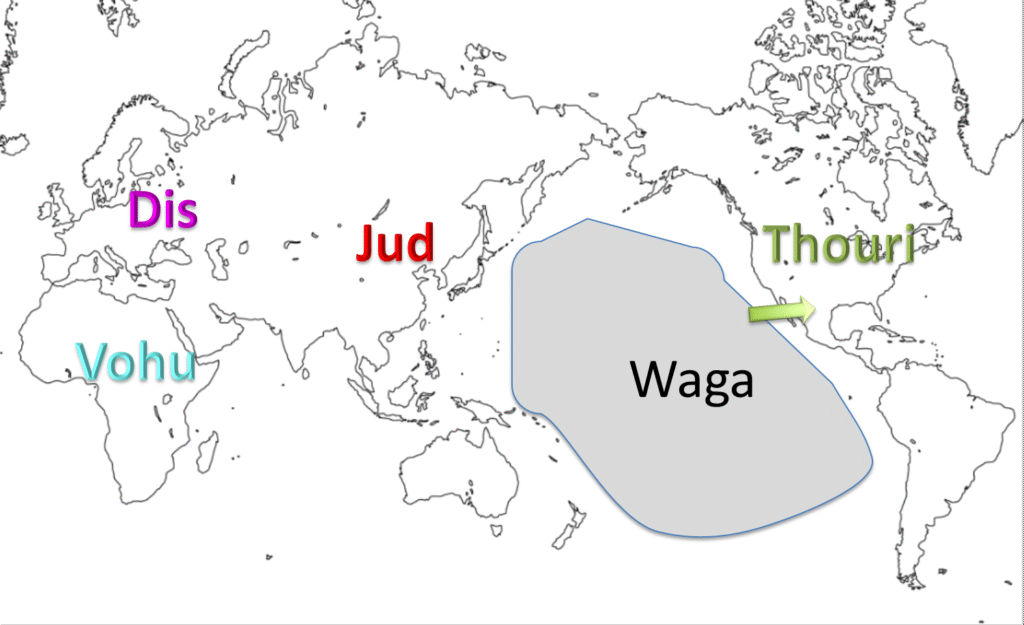About the World Before the Great Flood
After the Earth was formed and the first humans, known as the Asu (Asus), were created, the first deity of Earth—Archangel Sethantes—appeared approximately 73,000 years ago. At that time, he divided the land masses of Earth, including the ancient continent of Pan (which once existed in the Pacific Ocean), into five regions. Each region was assigned to one of five Gods (subordinate deities) for governance.
According to OAHSPE Book of Sethantes (OAHSPE 4:2-28), the names of the regions and their respective ruling Gods are as follows:
| 神 | 場所 |
|---|---|
| Dis | Europe |
| Jud | Asia |
| Waga | Pan |
| Thouri | America |
| Vohu | Africa |
These territories were each named after the Gods who ruled them. The continent of Pan, likewise, was also known as the “Waga Continent,” derived from the name of its ruling deity.

The Cause of the Sinking of the Continent of Pan
In OAHSPE, it is said that human souls have a spiritual “ranking.” The more virtuous and kind one’s life was, the higher the soul’s rank becomes. Conversely, those who live unethically tend to fall into lower ranks.
The spiritual world after death—known as heaven—also has its own hierarchical structure. The lower realms close to Earth are referred to as the Lower Heaven. Souls who continue to grow spiritually and raise their rank through discipline may eventually ascend to the Upper Heaven, also called Nirvana.

However, in order to be permitted into the Upper Heaven, a soul must reach at least a rank of 50. Those who fall short remain in the lower heavens and undergo spiritual training, service, or labor to continue their development. Some souls, on the other hand, remain overly attached to the earthly world after death. These spirits do not even ascend to the Lower Heaven and instead stay behind, often attaching themselves to the living. Such entities are known as druj or druja.
In some cases, individuals who engage in harmful acts from an early age may be under the influence of such druj. This is because, according to OAHSPE, before a person is born, their soul receives training in the heavens and is then reincarnated into the world with their previous memories erased.

The first God of Earth, Sethantes, struggled with the issue of souls who were unable to adapt to life in heaven and kept returning to Earth. If left unchecked, these souls could negatively affect living humans. To address this, angels in the heavens performed a kind of “surgical severance” to forcibly return the attached spirits to the spiritual realm.
If such interference was not performed, the affected human could develop symptoms like split personality—or in more severe cases, complete personality replacement. This is problematic because the person’s original soul becomes suppressed and unable to grow during their lifetime. Once the body dies, the original soul returns to heaven without having experienced any growth, while the possessing spirit, still full of earthly attachment, wanders in search of another body to possess—thus repeating the cycle.
If druj are left unchecked, the spiritual growth of humanity as a whole is hindered.
Because of this, the Gods and angels of the time regularly performed these severance procedures whenever possessions occurred.

However, there is a balance in the world between “good souls” and “corrupt souls.” When that balance tips and the number of evil souls rises sharply, not even the Gods and angels can keep up with the task. At that point, the world becomes overwhelmed by darkness, and divine intervention alone is no longer enough to restore balance.
This is exactly what happened on Earth around 24,000 years ago.
At the time, the ruling God was known as Neph. He made great efforts to save the world, but the spread of evil had gone too far. It had reached a state where redemption through divine power alone was no longer possible.
The Movement of the I’hins
In the Book of Genesis in the Old Testament, there is a famous story in which God instructs Noah to build an ark and save his family and various animals from a great flood (Genesis 6–8).

However, according to OAHSPE (Book of Wars Against Jehovih, Chapter 48:12), this biblical flood narrative is actually a distorted version of much older myths passed down on Earth. These myths were altered by the ancient Egyptian figure Osiris when he declared himself a creator god.
Osiris was originally a mortal man. In order to assume the role of a god, he needed to rewrite Earth’s traditional spiritual history and reframe the divine beings of old as god-men—mortal figures elevated to divine status.
As a result, the “Noah” who appears in the Old Testament is, in OAHSPE, not a single individual but a symbolic representation of the I’hins—an ancient race of humans capable of hearing the voice of the Creator. Osiris, in reshaping the story, reduced the collective legacy of the I’hins into the single character of Noah.
Why did Osiris choose the name “Noah”?
It is said that the great flood took place during a celestial phase known as the Noah Arc (or Noah Arc of the Great Serpent), a reference to a cosmic cycle. Osiris likely adopted this term strategically to redirect attention away from divine truths and celestial order.
At the time, Earth was becoming overrun by the corrupt and immoral. The virtuous I’hins were gradually driven out of their homes and forced to live in seclusion—deep within the mountains and valleys of the continent of Pan.
When the Creator Jehovih finally resolved to submerge the continent of Pan, the gods of Earth sent angels to warn and protect the I’hins. They were instructed to build ships in preparation for the coming disaster. In obedience, the I’hins worked together and constructed many vessels.
Eventually, the catastrophic flood came, and the I’hins who had hidden in the mountains and valleys boarded the ships they had prepared. They were able to escape and survive the great cataclysm.
It is said that a total of 34 ships were built. Two of them, which led the fleet, became separated during the voyage and eventually drifted to Yista—what we now know as Japan.
The remaining 32 ships split into four groups of eight and sailed to the four continents of Jaffeth, Shem, Ham, and Guatama.
Thus, the I’hins dispersed across the world. In each of these regions, their advanced spiritual knowledge and divine sensitivity greatly contributed to the development and flourishing of early civilizations.
About the I’hins Who Escaped to Yista (Japan)
The name “Japan” first appeared in Chinese historical records in the 7th century CE, during the Asuka period. Before that, the country was known as Wa.
However, in OAHSPE, the Japanese archipelago is not referred to as Nippon or Wa, but rather as Japan. One possible reason for this is that the islands of Japan are believed to be a remnant of the ancient continent of Pan—a portion of land that survived the great submersion.
The term Japan is thought to carry deeper meaning. The prefix “ja” is considered to correspond to “Jah” or “Yah” in Hebrew, which means “God.” When combined with pan, referring to the continent of Pan, the name Japan may signify “the Sacred Pan.”
The I’hins are said to have possessed advanced technological and spiritual abilities. Around 24,000 years ago, the Japanese islands were in what we now call the Paleolithic period. It is believed that the I’hins arrived in this land and, over time, helped cultivate a more advanced civilization—one that eventually led into the Jomon period.
A likely candidate for their landing site is the Tsugaru region in modern-day Aomori Prefecture, located in the northern part of Japan’s main island.
Ref : [The Lost Continent and Legend] The I’hins Who Escaped to Yista (Part 1)
About the I’hins Who Escaped to Regions Outside of Japan
Regarding the I’hins who escaped to regions outside of Japan, an intriguing point is found in the Old Testament. There, their presence appears to be recorded symbolically as the descendants of Noah—namely, his three sons: Shem, Ham, and Japheth.
Interestingly, Guatama (the American continent) is not mentioned in this record. This may be because there was no interaction or awareness of the American continent at that time. On the other hand, while Japheth (interpreted as China) is included, Yista (Japan) is absent. One possible explanation is that the I’hins who migrated to China had no direct contact or exchange with those who arrived in Japan.
From among the descendants of these I’hins, figures such as Abraham and other great spiritual teachers eventually emerged.
The story of these descendants will be explored in a future article.
References, Images used
| Books | authors | publishers |
|---|---|---|
| OAHSPE ”A New Bible in the Worlds of Jehofih and His angel embassadors.” | John B. Newbrough | OAHSPE PUBLISHING ASSOCIATION |
| 聖書 新共同訳-旧約聖書 | 共同訳聖書実行委員会 | 三省堂印刷/日本聖書協会 |
Image:Generated from stable diffusion(model:etherRealMix_etherRealMix4.safetensors)
Image:Generated from stable diffusion(model:XSMerge-RealisticVisionV3-ForArchi)



コメント